Author: Magdalena Wszelaki, hormone nutritionist, certified herbalist, published cookbook author with Harper Collins
⏱ Estimated Read Time: 9–10 minutes
What you will learn from this article:
How it all started
To escape the Colorado winters, I spend half the year living out of my Sprinter van, often in Mexico. The lifestyle is simple and minimalistic – dreamy in many ways – but it comes with challenges. One of the biggest is eating healthy while cooking from a tiny kitchen and juggling the time demands of running a business. I needed meals that were fast, high in protein, nourishing, and made me feel good – so I turned to protein powders.

But what I found in the market shocked me. Mind you – I look at food through the lens of a hormone nutritionist – and if you care about what you put in your body, you may find this article helpful.
Everywhere I looked, it was either whey or pea protein. As someone trained in endocrine nutrition, and as a woman in perimenopause, I know too much about both.
I’m also sensitive to dairy and pea protein – so both were off the list.
Whey makes me constipated, sluggish, and inflamed. Pea protein gives me digestive issues and makes me feel foggy. And then there’s the taste. Let’s just say: gritty, bitter, or “like ground-up furniture” are not things I want in my smoothie.
So, I decided to make my own. And this is how Her Protein was born.
In this post, I’m sharing my own analysis when I first started looking at protein powders and hopefully it will be a helpful guide for you to understand the protein powder landscape – and why the one you’re using may not be doing your body any favors.
Why Use Protein Powder At All?
There’s a misconception that protein powders are only for bodybuilders. Not so – especially for women over 40. As we age, muscle loss accelerates. After 45, we lose around 2% of muscle mass per year – that’s 60% muscle loss by age 75. Muscle loss can lead to weight gain, slower metabolism, frailty, and increased risk of injury.
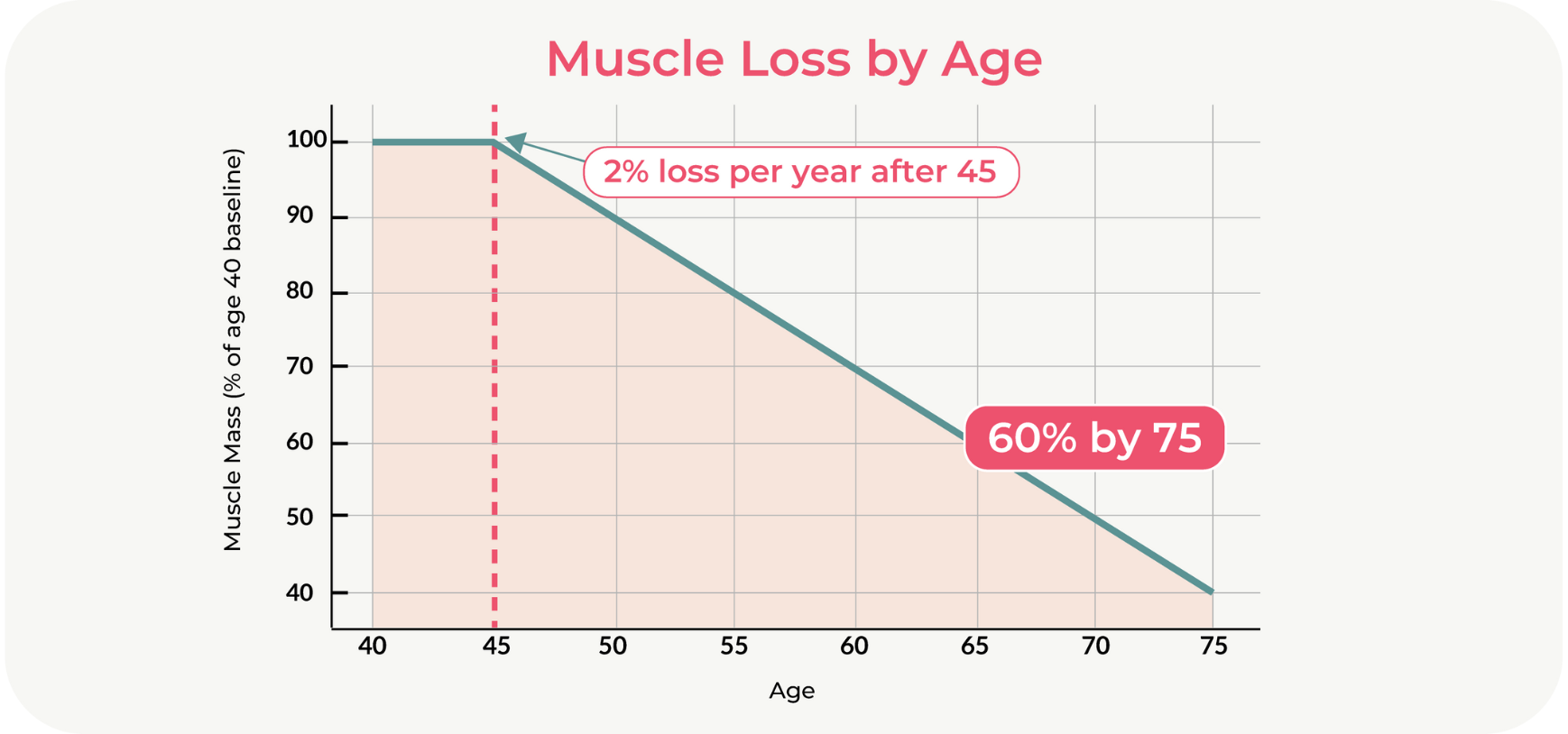
Protein isn’t just about pretty muscles – these muscles are what is keeping your metabolism running, your blood sugar balanced, your hormones happy, and your brain sharp. And let’s be honest: sometimes, it’s just easier to scoop, blend, and go.
How Much Protein Do Women Really Need? (Science vs My Own Experience)
Most women are under-eating protein, especially at breakfast. According to the latest research, women should aim for 1.2 grams of protein per pound of body weight per day.
Example: If you weigh 140 lbs (about 64 kg), you need around 168 grams of protein daily. That’s about 56 grams per meal.
That’s what research shows us.
Have I been doing it? Not really.
I’ve found it more practical and doable to do 1.4 grams of protein per kilo – so more like 24-30 grams per meal to hit my daily target of 90 grams. Am I deficient in protein? You would know it by seeing muscle wastage (sarcopenia), blood sugar issues, hormonal challenges – which I do NOT experience.
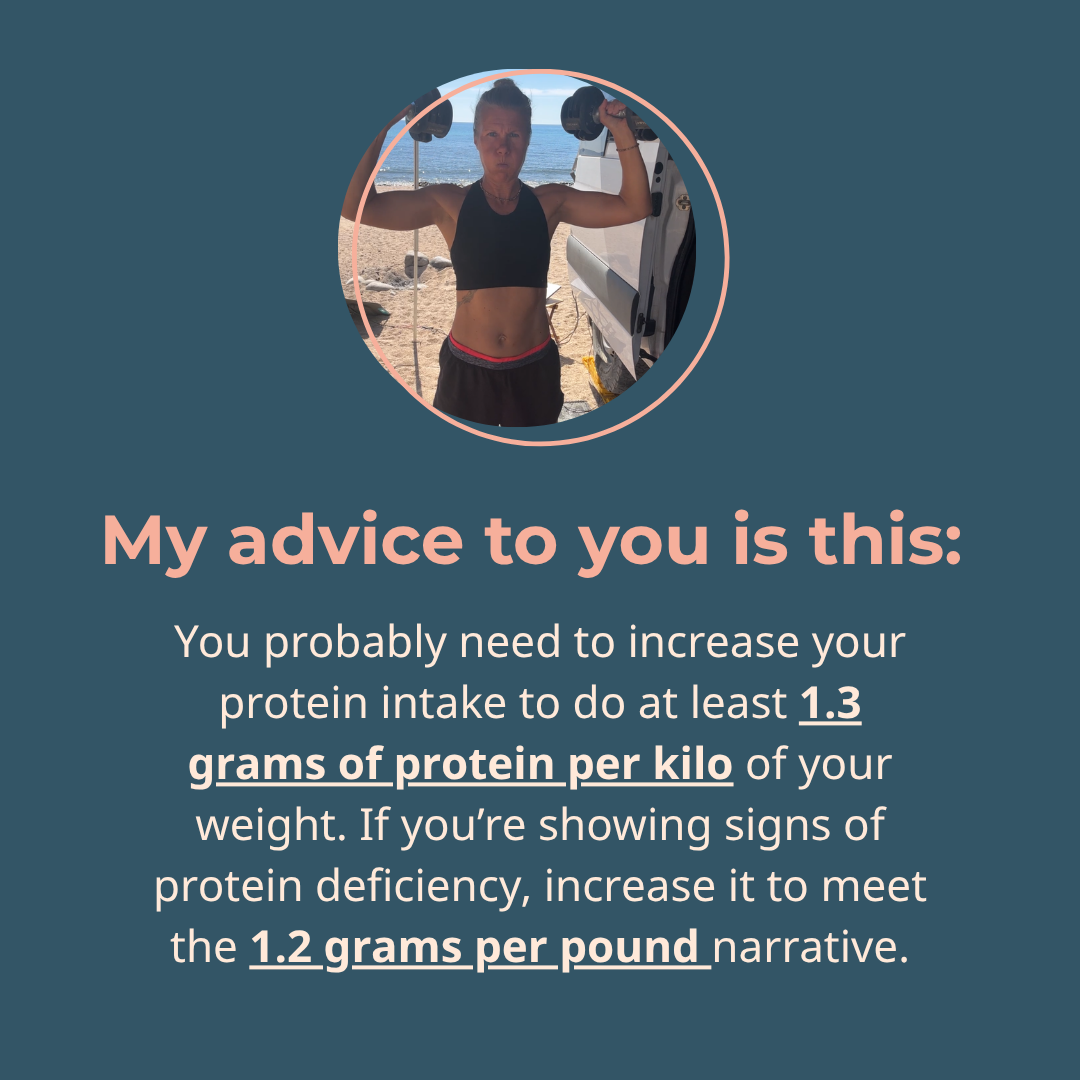
The bottom line is: an avocado toast isn’t going to cut it. Most women undereat protein and it’s not easy (in my experience), to hit these grams at each meal – that’s where a high-quality protein powder can be a game-changer.
The 4 Most Popular Protein Powders – and Their Pitfalls
When searching for a protein powder, I’ve run into the below issues.
1. Whey Protein
Whey is dairy-derived, complete, and highly bioavailable.
But:
- It contains dairy, and many women (like me) are sensitive to it (see the list of dairy sensitivity symptoms below).
- Most whey is from factory-farmed cows – not grass-fed and grass-finished cows.
- Brands rarely disclose sourcing or processing methods.
Whey isn’t inherently bad – it’s just not right for everyone, especially if you’re sensitive to dairy. Are you? Let’s find out – I have a list of symptoms for you below.
2. Pea Protein
A popular plant-based option. I’m honestly tired of the “plant protein is better” narrative as it’s highly flawed, here’s why.
Problems with pea protein:
- It’s an incomplete protein – it lacks methionine. Even if it’s added (some brands have begun to do that), the problem is absorption, see next point.
- It has poor absorption abilities – so the protein value they promise you, most likely isn’t getting absorbed.
- As a legume, it’s not as easily digestible for many people.
- Unless it’s USDA organic, it probably contains glyphosates from GMO peas.
- Many complain of gritty texture and unpleasant taste. (To me, it tastes like ground up furniture).
Again, not inherently evil – but not ideal for sensitive digestion or those with autoimmune conditions. To me, the taste is completely off-putting.
3. Collagen
Collagen is widely used for skin, joint, and hair health.
But:
- It’s not a complete protein – missing essential amino acids like tryptophan.
- Typically only offers 7–10g protein per serving.
- Not ideal as a primary protein source for muscle building or metabolic support.
Collagen can be a great supplement, but it should not replace a complete protein powder if you’re looking to build or maintain lean muscle, and metabolism.
4. Beef Protein
Often overlooked but incredibly powerful.
Pros:
- Complete protein that is allergen-free, dairy-free, and easy to digest.
- When sourced properly (like from grass-fed EU cows), it’s one of the cleanest proteins available.
Cons:
- Many brands taste gamey or don’t disclose how the cows were raised.
So here you have it – I’ve gone through the research and saw an opportunity – to solve all this with Her Protein.
Here is the summary of my analysis on protein powders.
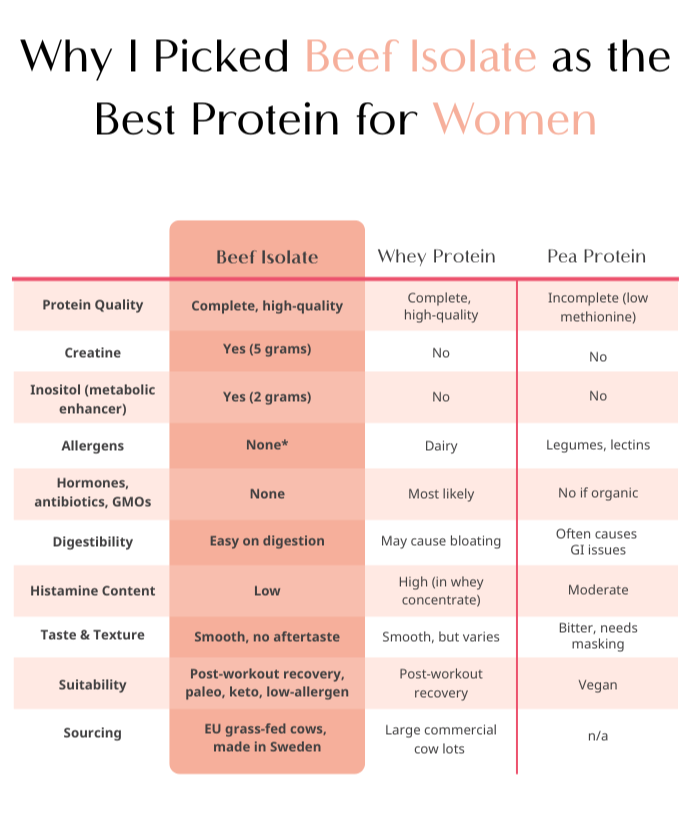
Could You Be Sensitive to Dairy and Not Even Know It?
Many women struggle with symptoms they can’t quite explain – like bloating, constipation (that’s one of my symptoms), IBS, fatigue, skin breakouts, brain fog, body pains and aches, or systemic inflammation – without realizing that dairy may be the culprit.
In fact, according to the National Institutes of Health, around 65% of people worldwide have a reduced ability to digest lactose after infancy [NIH, Lactose Intolerance, 2020]. Even among those who aren’t officially lactose intolerant, dairy sensitivity can trigger a wide range of subtle and chronic symptoms, especially in women over 40.
Common Symptoms of Dairy Sensitivity:
- Bloating or gas after meals
- Constipation and IBS
- Fatigue or sluggishness
- Skin issues (acne, eczema, rashes)
- Chronic sinus congestion
- Brain fog or poor concentration
- Puffiness or weight retention
- Systemic inflammation (a real problem for women after 40)
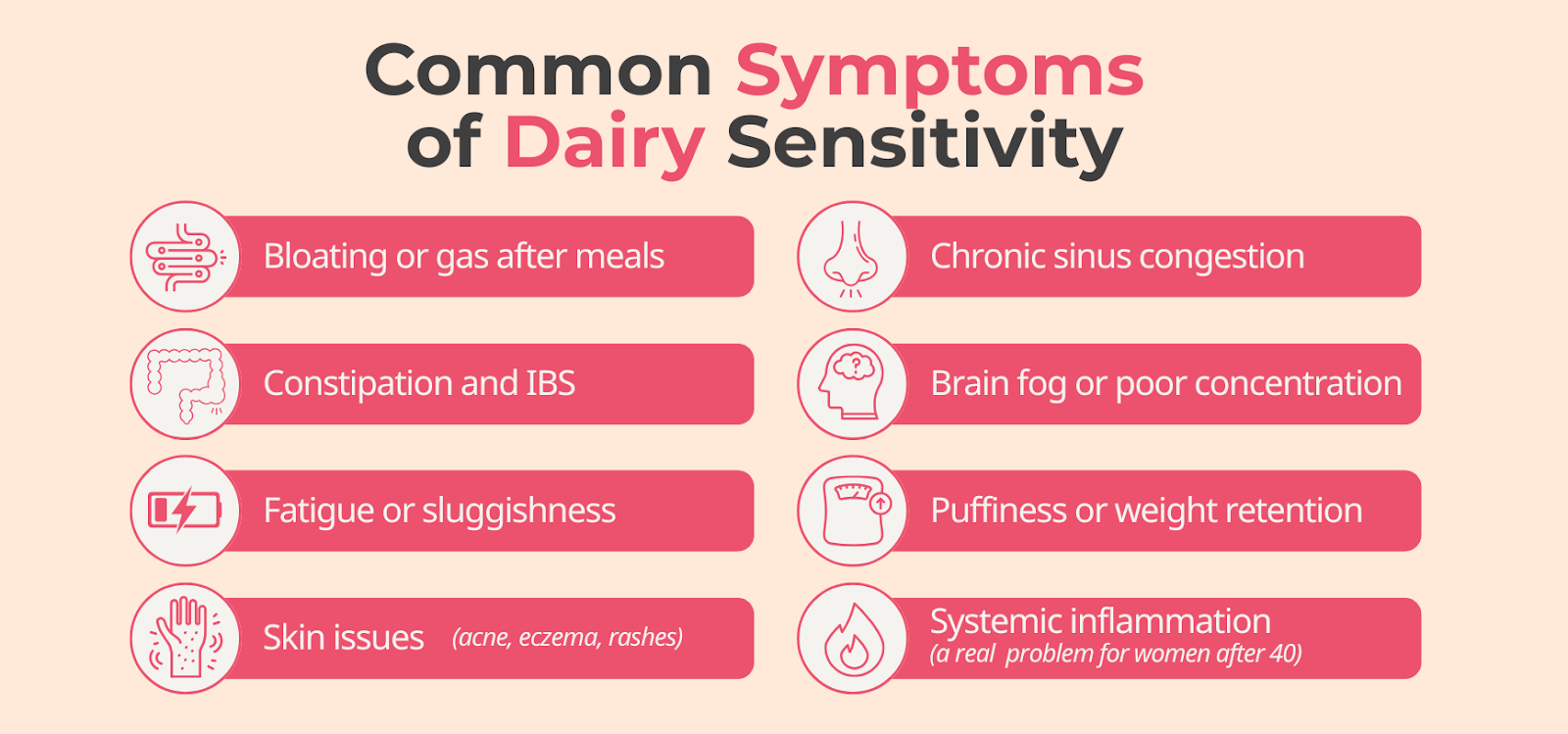
Because these symptoms are common and non-specific, many women chalk them up to aging, stress, or hormones. But eliminating dairy – even just for a few weeks – can reveal how much better you might feel without it.
That’s why I made sure that Her Protein is 100% dairy-free – no whey, no hidden casein, no inflammatory aftershocks.
How Whey and Pea Protein Can Mess With Your Hormones
Due to the inflammatory nature of pea protein and whey, many women experience hormonal imbalances. Inflammation is at the root cause of most hormonal problems. This is why in all my hormonal protocols, lowering inflammation is one of the first steps.
When inflammation is chronically present in women, this is what it can do.
For Younger Women:
The wrong protein choice can set the stage for long-term hormonal problems. Chronic inflammation from whey (because it’s dairy-based) or pea (because of its lectins and gut-disrupting compounds) can drive:
- PCOS (Polycystic Ovary Syndrome): linked to insulin resistance and chronic inflammation.
- PMS: worsening cramps, bloating, and mood swings.
- Estrogen Dominance: heavy periods, tender breasts, and stubborn weight gain.
- Thyroid Issues (hypothyroidism and Hashimoto’s): since inflammation can suppress thyroid function, leading to fatigue and slowed metabolism.
For Midlife Women:
Perimenopause and menopause already come with hot flashes, mood swings, sleep disruptions, and weight gain. Add inflammatory proteins on top, and it can feel like pouring gasoline on the fire. Women often experience:
- Intensified hot flashes and night sweats.
- Heavier, more erratic periods in perimenopause.
- More severe mood swings, anxiety, and brain fog.
- Harder-to-lose weight and increased belly fat.
In short: if your protein powder is inflaming your body, it’s also messing with your hormones – whether you’re 25 or 55.
That’s why choosing a clean, non-inflammatory protein source is so critical for women at every stage of life.
Why Source Matters More Than You Think
Most people don’t realize that not all beef protein is the same.
Cows raised in humane conditions, grazing on open pastures in places like the EU (where the treatment of animals and production standards are much higher than in the US), produce more nutrient-dense protein. Their meat (and therefore the protein) is higher in omega-3s, CLA, and fat-soluble vitamins.
Many protein powders come from cows that:
- Are fed GMO corn and soy
- Live in confined feedlots
- Are given preventive antibiotics and growth hormones
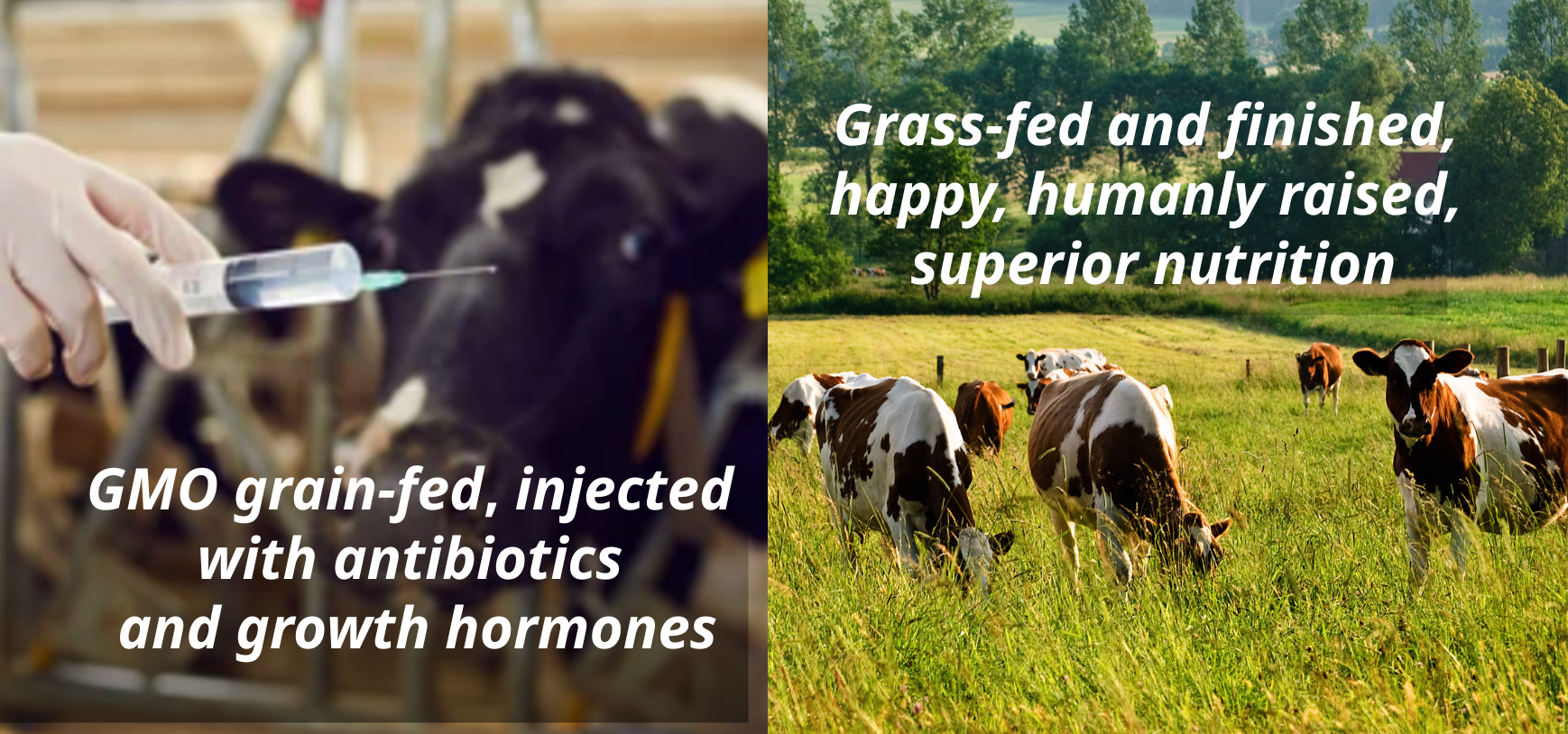
Would you want that in your body?
I did not.
This is why Her Protein uses beef isolate from grass-fed, grass-finished cows raised in the EU, processed in Sweden using low-heat, solvent-free extraction for maximum digestibility and purity.
Making Protein Powder for Women Even Better
I created Her Protein because I couldn’t find a protein powder that:
- Didn’t make me bloated
- Tasted good
- Came from a clean source
- Supported my hormonal health
- Wasn’t loaded with a long list of synthetic ingredients
For women in midlife, the needs are different. That’s why I added two crucial ingredients:
Creatine (5g)
- Supports lean muscle growth and strength
- Improves cognition and reduces brain fog
- Boosts physical performance and recovery
Medical citations:
- Creatine Supplementation in Women’s Health: A Lifespan Perspective PMID: 33800439
- Creatine Supplementation Beyond Athletics: Benefits of Different Populations PMID: 39796530
- A 2-yr Randomized Controlled Trial on Creatine Supplementation in Postmenopausal Women PMID: 37144634
- The effects of creatine supplementation on cognitive function in adults PMID: 39070254
Inositol (2g)
- Helps balance blood sugar and insulin
- Supports metabolism and energy
- Reduces anxiety and supports mood
Medical citations:
- Inositols in Midlife PMCID: PMC5879846 (metabolic syndrome improved blood pressure, HDL cholesterol, HOMA index (insulin sensitivity), total cholesterol, triglycerides, and reduced the overall incidence of metabolic syndrome)
- Long-Lasting Therapies with High Doses of D-chiro-inositol PMCID: PMC9821166
(decreased BMI, glycemia, insulinemia, and HOMA-IR, suggesting benefit for metabolic health and body weight regulation) - Inositol supplementation and body mass index: A systematic review
PMCID: PMC9159559 (reductions in BMI in women, especially in overweight and obese groups)
Together, these nutrients do what most protein powders can’t – support strength, metabolism, blood sugar levels, and mood.
What to Avoid in Protein Powders
When shopping, look out for:
❌ Synthetic vitamins and “superfood sprinkles”
❌ Sugar, sugar alcohols, artificial sweeteners
❌ Hidden allergens (like whey and soy)
❌ Long lists of unpronounceable ingredients
❌ Gritty texture and strong aftertaste
A protein powder should feel like food, not a chemistry experiment.
Why Did I Choose NOT to Formulate with Whey or Pea Protein?
After all, I could have chosen any protein source to formulate my own – whey and pea proteins are both far cheaper than beef isolate. Yet, I chose to make Her Protein from a beef isolate in order to deliver a hypoallergenic solution more women could consume.
Then, I also combined it with creatine and inositol – for a complete muscle and metabolic solution for women, especially after 40.
- 23g of complete, high-quality beef protein isolate
- 5g creatine and 2g inositol – no need to buy extra supplements
- Only 5 ingredients
- No sugar, no sugar alcohols (like xylitol), artificial sweeteners
- No dairy, soy, gluten, or pea
- Smooth taste and dissolves easily (just blend, don’t stir!)
- Comes in a smart, resealable Velcro bag (no spills)
What to Expect When You Switch to a Clean Protein
Like with most things, consistency is key. When you hit your protein targets, here is what you may start experiencing.
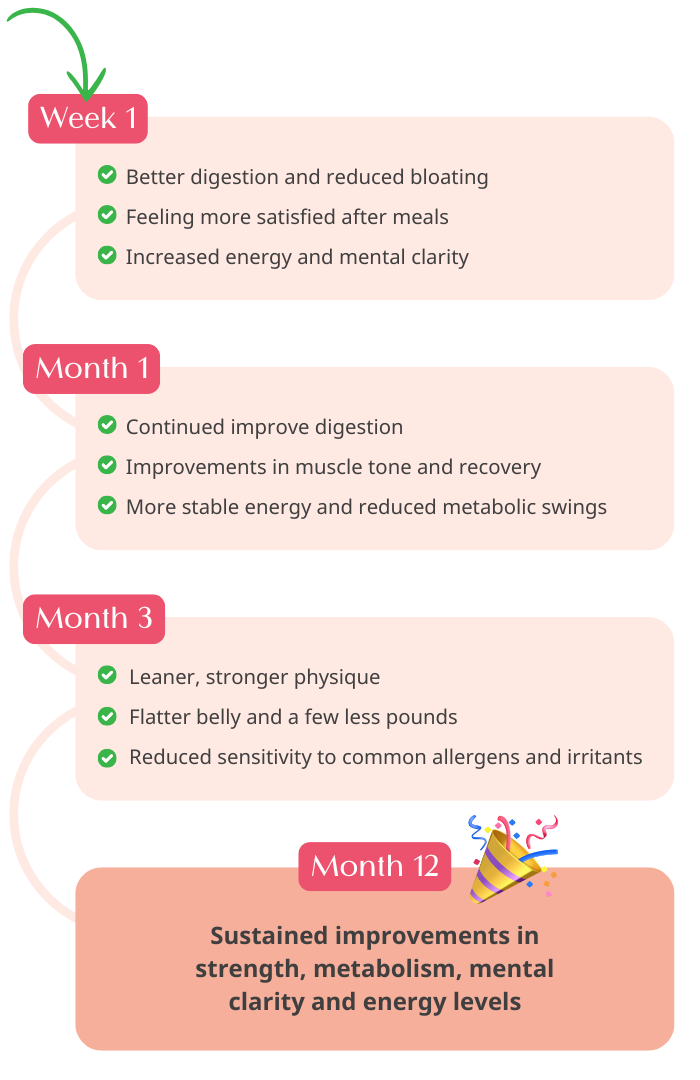
Week 1:
- Less bloating
- More satiety and reduced cravings
- Increased energy and mental clarity
Month 1:
- Improved muscle tone and workout recovery
- More stable blood sugar and fewer mood swings
Month 3:
- Leaner, stronger physique
- Better digestion and reduced inflammation
Month 6–12:
- Enhanced strength, metabolism, and hormonal balance
- Clearer skin and improved well-being
The Bottom Line: You Can Do Better with Your Protein
You shouldn’t have to choose between gut issues, poor taste, or questionable ingredients when it comes to protein powders.
I hope my process of how I think about protein will help you evaluate your options and what is best for your body. And if you’re compelled, try our Her Protein; the hypoallergenic, 3-in-1 solution (protein-creatine-inositol) from grass-fed, grass-finished EU cows.
If your current protein powder is making you bloated, tired, or inflamed, it’s time for a better solution.
Your body deserves clean, functional, delicious fuel.
Hey, I’m a stickler for what I put in my body. If my body is loving it, I think yours will too.
—Magdalena Wszelaki
Hormone nutritionist and creator of Her Protein